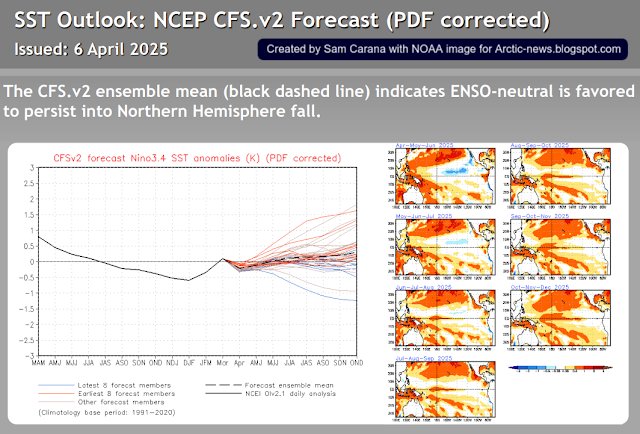 |
| [ click on images to enlarge ] |
Massive loss of albedo amplifies the decline of Antarctic sea ice and the decline of the snow and ice cover over Antarctica, resulting in elevated global temperatures that could persist through September 2026, when Arctic sea ice typically reaches its minimum extent.
 |
| [ from earlier post ] |
 |
| [ click on images to enlarge ] |
Moving from the bottom of a La Niña to the peak of a strong El Niño can in itself make a difference of more than 0.5°C, as discussed in an earlier post. The image on the right shows a NOAA update of Niño-3.4 region temperature anomalies and forecasts.
The image below, adapted from ECMWF, shows the ENSO anomalies and forecasts for developments through November 2026 in Niño3.4 (left panel) and in Niño1+2 (right panel), indicating that the next El Niño will emerge and strengthen in the course of 2026.
 |
| [ from earlier post ] |
Let's hope the 2026 Arctic sea ice volume (arrow) is not disappearing behind the legend.
There is a huge danger that seafloor methane and methane from thawing terrestrial permafrost will add strongly and abruptly to the temperature rise, as discussed in many earlier posts such as this one and as illustrated by the screenshot below.
 |
| [ screenshot from earlier post ] |
Greenhouse gases rising
Ominously, concentrations of greenhouse gases at Utqiaġvik (formerly Barrow), Alaska, are very high and rising. The image below shows daily measurements of carbon dioxide concentrations from 2020.
The image below shows monthly average methane measurements from 2001.
The image below shows monthly average nitrous oxide measurements from 2016.
Climate Emergency Declaration
UN secretary-general António Guterres recently spoke about the need for “a credible global response plan to get us on track” regarding the international goal of limiting the global temperature rise. “The science demands action, the law commands it,” Guterres said, in reference to a recent international court of justice ruling. “The economics compel it and people are calling for it.”
What could be added is that the situation is dire and unacceptably dangerous, and the precautionary principle necessitates rapid, comprehensive and effective action to reduce the damage and to improve the outlook, where needed in combination with a Climate Emergency Declaration, as described in posts such as this 2022 post and this one and as discussed in the Climate Plan group.
Links
• NSIDC - Sea Ice Today
https://nsidc.org/sea-ice-today
• Tropicaltidbits.com
https://www.tropicaltidbits.com
• The threat of seafloor methane eruptions
https://arctic-news.blogspot.com/2025/11/the-threat-of-seafloor-methane-eruptions.html
• Feedbacks in the Arctic
https://arctic-news.blogspot.com/p/feedbacks.html
• NOAA - Global Monitoring Laboratory - Data Visualisation - flask and station methane measurements
https://gml.noaa.gov/dv/iadv
• Focus on Antarctica
https://arctic-news.blogspot.com/2025/09/focus-on-antarctica.html
• Danish Meteorological Institute - Arctic sea ice volume and thickness
https://ocean.dmi.dk/arctic/icethickness/thk.uk.php
• University of Bremen - sea ice concentration and thickness
https://seaice.uni-bremen.de/start
• Extinction
https://arctic-news.blogspot.com/p/extinction.html
• Transforming Society
https://arctic-news.blogspot.com/2022/10/transforming-society.html
• Climate Plan
https://arctic-news.blogspot.com/p/climateplan.html
• Climate Emergency Declaration
https://arctic-news.blogspot.com/p/climate-emergency-declaration.html
UN secretary-general António Guterres recently spoke about the need for “a credible global response plan to get us on track” regarding the international goal of limiting the global temperature rise. “The science demands action, the law commands it,” Guterres said, in reference to a recent international court of justice ruling. “The economics compel it and people are calling for it.”
What could be added is that the situation is dire and unacceptably dangerous, and the precautionary principle necessitates rapid, comprehensive and effective action to reduce the damage and to improve the outlook, where needed in combination with a Climate Emergency Declaration, as described in posts such as this 2022 post and this one and as discussed in the Climate Plan group.
Links
• NSIDC - Sea Ice Today
https://nsidc.org/sea-ice-today
• Tropicaltidbits.com
https://www.tropicaltidbits.com
• The threat of seafloor methane eruptions
https://arctic-news.blogspot.com/2025/11/the-threat-of-seafloor-methane-eruptions.html
• Feedbacks in the Arctic
https://arctic-news.blogspot.com/p/feedbacks.html
• NOAA - Global Monitoring Laboratory - Data Visualisation - flask and station methane measurements
https://gml.noaa.gov/dv/iadv
• Focus on Antarctica
https://arctic-news.blogspot.com/2025/09/focus-on-antarctica.html
• Danish Meteorological Institute - Arctic sea ice volume and thickness
https://ocean.dmi.dk/arctic/icethickness/thk.uk.php
• University of Bremen - sea ice concentration and thickness
https://seaice.uni-bremen.de/start
• Extinction
https://arctic-news.blogspot.com/p/extinction.html
• Transforming Society
https://arctic-news.blogspot.com/2022/10/transforming-society.html
• Climate Plan
https://arctic-news.blogspot.com/p/climateplan.html
• Climate Emergency Declaration
https://arctic-news.blogspot.com/p/climate-emergency-declaration.html







































